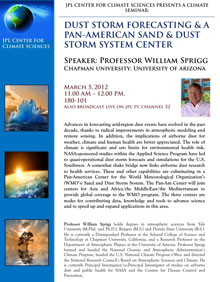Seminars
Dust Storm Forecasting and a Pan-American Sand and Dust Storm System Center
Professor William Sprigg, Chapman University; University of Arizona
March 5, 2012 | Jet Propulsion Laboratory, 11.00 am-12.00 pm, 180-101
About this Lecture

Advances in forecasting arid-region dust events have evolved in the past decade, thanks to radical improvements in atmospheric modeling and remote sensing. In addition, the implications of airborne dust for weather, climate and human health are better appreciated. The role of climate is significant and sets limits for environmental health risk. NASA-sponsored studies within the Applied Science Program have led to quasi-operational dust storm forecasts and simulations for the U.S. Southwest. A somewhat shaky bridge now links airborne dust research to health services. These and other capabilities are culminating in a Pan-American Center for the World Meteorological Organization’s (WMO’s) Sand and Dust Storm System. The Pan-Am Center will join centers for Asia and Africa/the Middle-East/the Mediterranean to provide global coverage to the WMO program. The three centers are nodes for contributing data, knowledge and tools to advance science and to speed up and expand applications in this area.
About Professor William Sprigg

Professor William Sprigg holds degrees in atmospheric sciences from Yale University (M.Phil. and Ph.D.), Rutgers (M.S.) and Florida State University (B.S.). He is currently a Distinguished Professor at the Schmid College of Science and Technology at Chapman University, California, and a Research Professor in the Department of Atmospheric Physics at the University of Arizona. Professor Sprigg formed and headed the National Oceanic and Atmospheric Administration’s Climate Program, headed the U.S. National Climate Program Office and directed the National Research Council’s Board on Atmospheric Sciences and Climate. He is currently Principal Investigator/co-Principal Investigator of studies on airborne dust and public health for NASA and the Centers for Disease Control and Prevention.
